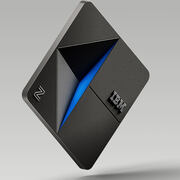IBM Z Offers Powerful Scalability, Robust Security and High Performance
Overall Satisfaction with IBM Z Enterprise Servers
IBM Z Series Enterprise Servers provide the power and reliability needed for the largest organizations to drive large numbers of transactions and gain insight from their data. If you are looking for a platform with high availability that can scale on demand and deliver performance with optimal security, these things are second nature to mainframe computer systems and applications.
The mainframes I have worked on are typically used across the whole organization to address the enterprise business needs of the organization. They run multiple applications for multiple business lines.
The mainframes I have worked on are typically used across the whole organization to address the enterprise business needs of the organization. They run multiple applications for multiple business lines.
Pros
- Security is a specific strength of the Z platform. The IBM z14 provides Pervasive Encryption, making the platform one of the most secure hardware offerings available. Specialized cryptographic hardware is utilized to encrypt data and protect encryption keys, enabled through integration with a tamper-responding cryptographic HSM. The IBM z14 pervasively protects all application and database data, without interrupting business applications and operations, all the time, at any scale. True end-to-end data protection is provided for all in-flight network data and APIs. Imagine being able to protect all your data and applications without requiring IT or programmer action. With the z14 this becomes reality instead of imagination.
- IBM offers flexible pricing options to make it easier for customers to affordably adopt and utilize the Z enterprise servers for any type of workload that needs to be run. For example, with Container Pricing, customers can identify workload to containers and pay for them independently of any other workload at a reduced price. Container Pricing is an important breakthrough for mainframe customers because it offers competitive economics versus alternative platforms such as public clouds and on-premises x86 servers.
- The IBM z14 delivers high-end processing power and enhanced I/O capabilities. The latest model, the z14, offers increases in the performance of the individual PUs (processor units), increases in the number of PUs per system, a redesigned system cache, and an increase in the amount of memory possible.
- The system is capable of running more than 12 billion encrypted transactions per day on a single system. And the IBM z14 delivers industry leading scale to meet the needs of modern connected workloads. It can run a million Docker containers on single platform.
- The mainframe and z/OS have a long history of providing critical business value with transaction processing systems like CICS and IMS. And the transactions processed by these systems are often backed by DB2 and IMS databases. The applications and databases hosted on mainframe systems provide a rich tapestry of useful information that mobile users want to access.
- And mobile devices can connect to the System z platform consistently and effectively. With z/OS Connect the mainframe can use a single interface on z/OS that accepts standard mobile protocols and formats that can interact with multiple systems on the mainframe.
- The Z platform provides a superior platform for analytics & machine learning for continuous intelligence across the enterprise. The Machine Learning on Z platform, delivered in 2017, offers an agile machine learning solution that enables customers to convert enterprise data into opportunity. With machine learning on an IBM z14 you can optimize your decision processes by quickly training, deploying and continuously monitoring a high volume of high quality predictive behavioral models. The IBM z14 can also rapidly analyze large volumes of data with consistent response times by exploiting the additional memory and faster processors of the z14.
- Modern development techniqes and languages can be used, in addition to legacy systems. And Linux can be run on enterprise Z servers just as easily as z/OS.
- And the platform excels at traditional, transactional workloads, both online and in batch, using database systems, flat files, or VSAM.
Cons
- IBM needs to add more focus on simplifying mainframe usage and management.
- Most modern programmers interface with the Z using an IDE. However, performing many tasks, such as cataloging a data set or checking on a job status, can require switching to the ISPF interface. Users want to interface with a GUI, not a function-key, menu and character-based interface like ISPF. Anything that can simplify and modernize interfacing with the mainframe should be a high priority for IBM.
- The IBM Z platform is one of the most instrumented computing platforms in the world, so there are a lot of metrics that could be automatically analyzed and used to improve the performance and management of the mainframe environment.
- The ROI of the IBM Z Enterprise Server is competitive with other platforms when calculated over the lifetime of the platform. Sometimes the higher initital cost scares off folks who do not work to identify the lifetime ROI of the servers.
- The many pricing options available for the Z platform can be confusing and hard to manage. That said, there is likely to be an ideal pricing option for your specific requirements among the many pricing options available.
- With IBM's advanced workload licensing users can control costs using defined capacity settings.
- Lenovo Flex System Blade Servers (formerly IBM BladeCenter)
I have been working with Z Enterprise Servers for 30 years and they have been called many different things over those years: mainframe being the name I am still most comfortable with. I choose to work with them because of their high availability, transaction processing capabilities, scalability and legacy support.



Comments
Please log in to join the conversation